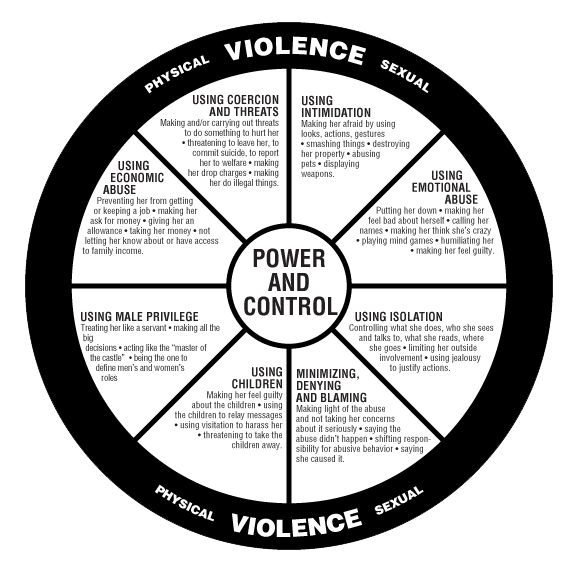|
Domestic Violence
Main
Points
Domestic violence is a widespread problem that occurs among all ages,
genders, races, educational backgrounds, and socioeconomic groups.
Emergency physicians are patient advocates who
see the problem firsthand and can play an important role in breaking the cycle of domestic violence.
For help, victims of domestic violence should talk to their physicians or call the National Domestic
Violence Hotline at 1-800-799-SAFE.
The American College of Emergency Physicians
encourages emergency personnel to screen patients for domestic violence and to appropriately refer any of them who indicate
domestic violence may be a problem.
Q. What is domestic
violence and who are its victims?
A. Domestic violence, also known as partner abuse, spouse abuse, or battering, occurs
when one person uses force to inflict injury, either emotional or physical, upon another person they have, or had, a relationship
with. It occurs between spouses and partners, parents and children, children and grandparents, and brothers and sisters. Victims
can any age, race, or gender.
Q. How extensive is the problem?
A. Domestic violence is the single largest cause of injury to women
between the ages of 15 and 44 in the United States, more than muggings, car accidents, and rapes combined. Each year between
2 million and 4 million women are battered, and 2,000 of these battered women will die of their injuries. Violence against
men by women is also a problem, according to the August 2000 Annals of Emergency Medicine. In a study of an inner city hospital,
men reported slightly more physical violence than women (20 percent of men and 19 percent of women), although women reported
significantly more past and present nonphysical violence than men.
Violence against women is an urgent public health problem with devastating consequences for women,
children, and families. According to the U. S. Department of Justice, an intimate person - a husband, ex-husband, boyfriend,
or ex-boyfriend - commits 29 percent of all violence against women by a single offender.
Nearly 18 percent of women
surveyed, or 17.7 million American women, have been raped or been a victim of attempted rape during their lifetime, according
to a collaborative study on violence jointly funded by the Department of Health and Human Services and the Department of Justice.
Research shows that approximately 900,000 parents are beaten or abused by their children each year. The National Elder
Abuse Incidence study found that approximately 551,011 elder persons were abused or neglected in a 1-year period (1996). Approximately 2 million children in the United States are seriously abused by
their parents, guardians, or others each year, and more than 1,000 children die as a result of their injuries. Recent studies
suggest that approximately 20 percent of children will be sexually abused in some way, usually by someone they know, before
they become adults. (See ACEP's Feature Column on "How to Protect Children
from Abuse")
Q. Who are the most common victims of domestic
violence?
A. There is no typical victim. Domestic violence occurs among all ages, races, and socioeconomic classes.
It occurs in families of all educational backgrounds. Individuals may be living together or separated, divorced or prohibited
from contact by temporary or permanent restraining orders.
Q. What can emergency physicians do to assist victims of
domestic violence?
A. Despite the magnitude of the problem, identifying domestic violence victims is still a complex
task. It is difficult to determine whether someone fell or was pushed, and emergency physicians are working to improve the
identification of domestic violence when it occurs. ACEP encourages emergency personnel to screen patients for domestic violence
and appropriately refer those patients who indicate domestic violence may be a problem in their lives.
The first thing a physician can do is recognize the
signs of violence. These vary depending upon the type of abuse and the victim's position in the family. Medical findings such
as these should prompt direct questioning about domestic violence:
Central
pattern of injuries.
Contusions or injuries in the head, neck or chest.
Injuries that suggest a defensive
posture.
Types or extent of injury that are inconsistent with the patient's explanation.
Substantial delay
between when the injury occurred and when the patient sought treatment.
Injuries during pregnancy.
Pattern
of repeated visits to the emergency department.
Evidence of alcohol or drug abuse.
Arriving in the emergency
department as a result of a suicide attempt or rape.
Physicians
also can gain clues from observing a patient and his or her partner. For example, a battered patient may seem evasive, embarrassed,
or inappropriately unconcerned with his or her injuries while the partner may be overly solicitous and answer questions for
the patient. A partner of the victim may be openly hostile, defensive or aggressive, setting up communication barriers between
emergency personnel and the patient.
Some physicians need to become familiar with the emotional, psychological, and social issues that
can predispose someone to accept abuse. They also should become familiar with the clinical presentations of domestic violence
and be aware of any personal prejudices or misunderstandings that may prevent them from considering this possibility.
Q. When emergency
physicians know or suspect abuse, are they required to report it?
A. Battery is a crime, and yet few states specifically
require reporting of domestic violence. A small number of states require mandatory arrest of batterers, and a few jurisdictions
aggressively pursue cases of domestic violence and prosecute batterers even when victims refuse to press charges.
Even when emergency physicians detect abuse, mandatory reporting to authorities-especially
against a victim's will-may not be the best thing to do because it can put the victim at greater risk of injury and even death.
Studies show that women who leave batterers are at a 75-percent greater risk of being killed by them. Virtually all jurisdictions
impose civil or criminal penalties for failing to report suspected incidents of child abuse or neglect.
It is extremely
important for emergency physicians to know their state laws and how their local criminal justice systems deal with the issue
so they can properly and adequately inform their patients.
Q.
What kinds of help can emergency physicians offer to victims of domestic violence?
A. Since family violence often makes
victims feel helpless and alone, emergency physicians can play an extremely important role in breaking the cycle of domestic
violence.
Even if a victim
is not ready to leave the relationship or identify the batterer, physicians can recognize and confirm to him or her that this
is a serious problem that must be solved. Emergency physicians can let victims know they are not alone, they don't deserve
to be beaten, and help is available.
Every emergency department should have written material with the names and telephone
numbers of local shelters, advocacy groups and legal assistance to give to patients if they feel it is safe to take it.
American College of Emergency Physicians:
June 2003

Domestic Violence: Protecting Yourself and Your Children
What
is domestic violence?
Domestic violence is abuse by a caregiver, a parent,
a spouse or an intimate partner. It can take many forms. Here are some types of abuse: Physical abuse is the use of physical
force; sexual abuse means any forced sexual activity; emotional abuse includes threats, constant criticism and put-downs.
Controlling access to money and controlling activities are other abusive behaviors.
What should I know about domestic violence?
Violence against a partner
or a child is a crime in all states. Each year, at least 2 million women are abused in this country. Abuse happens to people
of all races, ages, incomes and religions.
People who are hurt by their partners or parents do not cause the abuse.
Alcohol and drugs do not cause abuse, although they can make the violence worse. Abuse can begin, continue and increase during
pregnancy.
What can I do if my children or I am abused?
First, make sure you and your children are safe. Go to a safe place, such as the home of a friend or a relative
or an emergency shelter. Take your children with you. Call the police if you think you can't leave home safely or if you want
to bring charges against your abuser.
If possible, take house keys, money and important papers with you. Do not
use drugs or alcohol at this time because you need to be alert in a crisis. The staff members at emergency shelters can help
you file for a court order of protection.
What are other ways I can get help
if I am abused?
Talk to your doctor, who can treat any medical problem, provide
support and make referrals. Call an emergency shelter and ask about counseling and support groups for you and your children.
Nurses, social workers and other health care professionals can also help you.
Other
Organizations
National Coalition Against Domestic Violence
http://www.ncadv.org
National Domestic Violence Hotline
http://www.ndvh.org
800-799-7233
|

